
|
|
Located north of Woodstock, Vermont, Suicide Six is a historic small but steep ski area.
America's First Ski Lift
Woodstock, Vermont was an early hotbed for skiing, producing one of the first ski clubs in the country. In December 1931, the Woodstock Ski Runners was formed with J. Dwight Francis credited as founder and treasurer, Olympian John Carleton as president, and future Olympian Alexander Bright as vice president. Despite a lack of snow in the region, the club likely held its first ski race during the 1931-32 season.
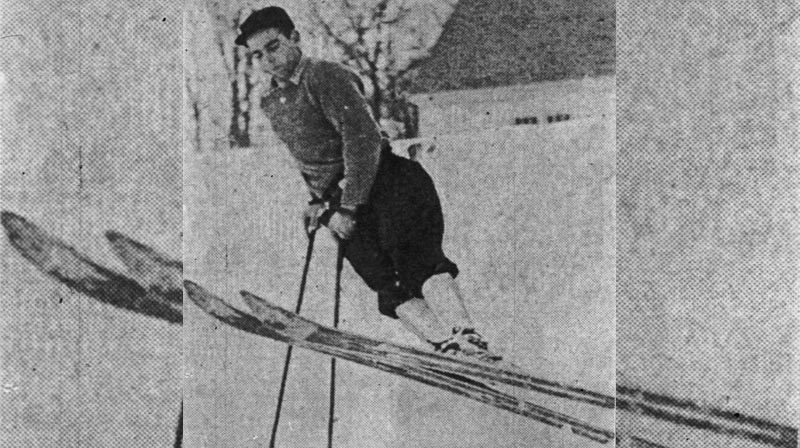
Bunny Bertram demonstrating a stop turn in the 1930s |
The Woodstock Ski Runners membership grew to about 100 members by the start of the 1932-33 season. Meanwhile, recent Dartmouth College graduate Wallace "Bunny" Bertram worked as a ski instructor in affiliation with the White Cupboard Inn. A Rhode Island native who had been studying zoology to follow in his father's footsteps as a veterinarian, Bertram had become captain of the Dartmouth College ski team. Bertram reportedly discovered Woodstock during a search for snow when Hanover was suffering through a mild winter. Elizabeth and Robert Royce started the White Cupboard as tea room and gift shop in 1915 and subsequently acquired the New Park Hotel in 1917, rebranding it as the White Cupboard Inn.
In January 1934, Bertram provided ski instruction to three White Cupboard Inn guests, William Douglas Burden (future High Pond owner), Thomas Gammack, and Barklie Henry. Having recently enjoyed European lift-served skiing, the three "cajoled" the Royces into constructing a rope tow, even providing the capital for the project. Bertram himself had been reportedly planning to develop a lift, however the Royces hired David Dodd to construct it and entered into an agreement with Clinton Gilbert to use his pasture north of town off Route 12. Bertram assisted with the operation of the rope tow during its debut season, which is recognized as the first ski lift in the United States. Bertram also worked as a chauffeur for the Fisk family, often taking the children skiing.
Bertram was able to beat the Royces to the punch in securing an agreement with Gilbert for the 1934-35 season, renaming the area to the "Woodstock Ski Hill.' Looking to provide a more reliable lift ride, Bertram was able to install an electric rope tow with improved sheaves and pulleys. Night skiing was also offered.
Woodstock Ski Tow in the Gully
Following a financial dispute with Gilbert, in the spring of 1935 Bertram announced his operation would be relocated. The Fisk family acquired a tract of land known as "The Gully" and Bertram began clearing the land and likely installing two electric rope tows.
Late in the summer of 1935, work commenced on a new club house at the new Woodstock Ski Tow area. The new location was named as the headquarters for the Woodstock Ski Runners. Meanwhile, Jim Parker developed the future Mt. Tom ski area.
The 1935-36 season likely kicked off in late December, following a five-inch snowfall.
Suicide Six Is Born
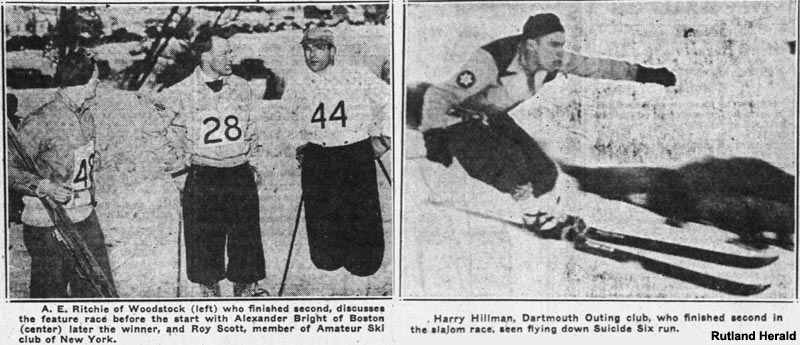
The 1937 Fisk Trophy |
In July 1936, news emerged that Bertram had acquired 30 acres of land (reportedly for $3 per acre) on the other side of the hill, also known as Perry Hill or Hill 6. In October, the Vermont Standard described the new terrain as "steeper'n a cow's tail" and would make a "veteran skier's scalp tingle." One writer joked about the lift being a "90-mile-an-hour speedy pull-me-up." Noting that it would be suicide to ski straight down the face, and recalling a lesson in alliteration in high school, Bertram chose the name Suicide Six.
Operating under the banner of Bunny's Tows, Bertram's operation likely started the 1936-37 season with minimal snowpack on December 5. The Suicide Six side was previewed by "only a few veteran skiers," but was otherwise closed due to lack o snow. The Gully side saw decent crowds during Christmas weekend, however "spring-like weather" wiped out the snow before the New Year's holiday. Skiing resumed in early 1937 with "crusty" conditions on snow that was "not ideal."
In February, Suicide Six was in operation, hosting the annual Woodstock Ski Runners race. With an award being donated by the Fisk family, the race was referred to as the Fisk Trophy this time around and was won by Alexander Bright with Harry Hillman coming in second. Rain arrived a few days later, resulting in an "exodus of 250 winter sports enthusiasts," according to the Rutland Herald.
After three weeks of little or no skiing, a snow storm resumed skiing in mid-March on a base of 6 to 8 inches. With in a few days, the Rutland Herald was praising conditions that were better "than at any time during the entire season." Total ski revenue in Woodstock was reported at $21,682 that winter, despite the "scarcity of snow." Meanwhile, Suicide Six was quickly making a name for itself. In April, Brad Mead, future founder of Pico, sent word from Europe that Suicide Six was superior to the runs and lifts he was experiencing at Davos.
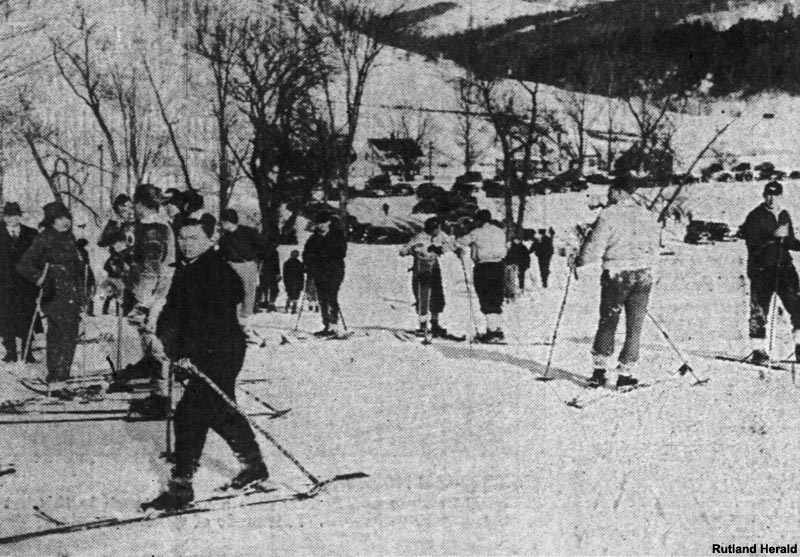
The Suicide Six base area in 1937 |
The access road to Bunny's Ski Tows base area was improved during the summer of 1937. Meanwhile, Bertram was raising money to increase the promotion of Woodstock as a ski destination.
In December, word emerged that Sig Buchmayr and Kurt Thalhammer would be offering ski instruction and race coaching. The season likely started on the Gully on December 10, with the Rutland Herald describing the "blanket of crust and ice, over which there lies an inch or so of powder snow" as being "hazardous," yet "nearly as good as any day last winter." Suicide Six likely remained idle until the second weekend in January due to lack of snow.
Meanwhile, racing activity was on the ascent. In January, Woodstock High School organized a ski team and held time trials at Bunny's Ski Tows, coached by Bertram, Buchmayr, and Thalhammer. A 16.5 mile cross-country race was planned for early February, slated to run from the Bertram ski lodge to the Hanover Inn in New Hampshire. However, a lack of snow resulted in the race being cancelled. Suicide Six nevertheless was able to host the annual Fisk Trophy race a week later, albeit in rain.
Woodstock continued to see a growing profile. Celebrities of the era who visited the region's ski areas that winter included future Vice President Nelson Rockefeller, General Pershing's son Jack, Charles Lindbergh's brother-in-law Dwight Morrow Jr., Princess Torlonia, Countess Villa.
Dealing with lean winters, Bertram cut new, more shaded trails for the 1938-89 season. Sig Buchmayr returned as ski school director.
Momentum was building. The 1938-39 season started in late November on Bunny's Ski Tows, though Suicide Six was not skiable until early January. Christmas was without snow (the Rutland Herald quipped, "Bunny Bertram frowned at the sky"), but a subsequent storm in time for New Year's brought Woodstock its busiest weekend in history to that point, with Bunny's Tows seeing 400 skiers.
Suicide Six hosted the Vermont slalom championship in mid-January, with the initial course described as "so fast [that] skiers found it almost impossible to remain upright." According to the Vermont Standard, "there were several spots where the covering was extremely thin and only the thirty men with the fastest times were permitted to run in the second round." The Rutland Herald described it as "almost 'suicidal' to attempt." Thanks to additional snowfall, Suicide Six hosted the Eastern Interscholastic ski championships two weeks later. In late February, Harry Hillman won the Fisk Trophy, with Williams College student and future famed ski filmmaker John Jay coming in eighth.
The 1940s
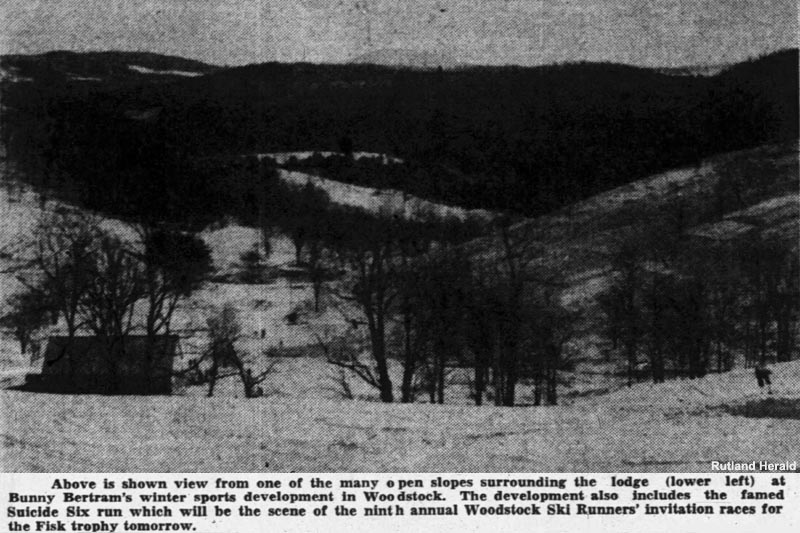
Bunny's Tows in the early 1940s |
For the 1939-40 season, improvements included the upgrade of a rope tow motor to increase capacity and the cutting of another trail. Arthur Schlatter took over as ski school director. The New York Times declared that Suicide Six was "one of the best courses in the country."
Bunny's tows had intermittent starting in January due to warm weather and a lack of snow. Oscar Cyr was named ski school director later in the month. The Fisk Trophy was held in early February on Suicide Six, with Wendy Cram winning the men's title and Margaretta Fisk winning the woman's title. The race was overshadowed by ski thefts, including those of Fisk's sister. One week later, Doug Mann won the United States Eastern Amatuer Ski Association Slalom Championship at Suicide Six. One week after, the area hosted the Eastern Interscholastic ski meet. Due to a wind event, conditions on the main Suicide Six slope were deemed too dangerous, so the race was held on the adjacent Satan's Schuss.
The 1939-40 season likely came to a close in late March, as a downpour washed out the road to Bunny's Tows on March 31.
Harold "Hal" Hillman, 1940 United States Olympic team selection, took over as ski school director for the 1940-41 season, which featured a new trail on Suicide Six. The season likely started in early December. The area managed to host the Fisk Trophy race in February, despite thin, icy conditions. The Dartmouth Winter Carnival was relocated to Suicide Six soon thereafter, "giving proof to the statement that when there is little or no snow elsewhere, Woodstock has it," according to the Vermont Standard.
Meanwhile, Suicide Six was developing a reputation for being dangerous. Prominent skiers such as Otto Schniebs, Wendy Cram, Alex Bright, and Joe Ward sustained serious injuries at the area in 1940 and 1941.
In January of 1941, Bertram went to Boston to obtain parts for a new 600 foot rope tow, likely manufactured by Underwood Machinery Company. In February, his new invention, a mobile Ford Model A unit dubbed the "Speed Tow," was put into use. Later known as the "Trick Whirlwind," it was reportedly "controlled by the operator, who keeps one hand on the gas and the other on the clutch, increasing the speed at will." Installed adjacent to the Gully lodge on a floodlit slope, it could support one person at a time. As stated in the Vermont Standard, "You can travel 8 miles an hour, or 80. It's up to the individual skier." The lift was set up with a rise to allow for a jump at the end of the ride, when maximum speed had been reached. According to the Rutland Herald, the fastest speed recorded during the first weekend was 91 miles per hour, and the longest jump was 42 feet. Plans were made to produce additional Speed Tows.
World War II
Shortly after the attack on Pearl Harbor, Woodstock picked up its first sizable snow storm of the season. Unfortunately, much of it was lost in pre-Christmas rain. Bunny's Tows may have started spinning just after Christmas. An early January storm boosted business, drawing a crowd of 500. Conditions quickly faded, resulting in a thin, firm base. By the start of February, races had to be held on the lower mountain. Even with the truncated course, the Rutland Herald reported that, "conditions were so bad...that one judge, situated part-way up the last pitch, slid on his face and stomach nearly 50 feet when he leaped for a flag knocked loose by an errant slalomer." An early March heatwave may have brought the season to a close. Suicide Six would likely not operate again until the end of the war.
As World War II ramped up, Bunny Bertram joined the United States Marines, eventually ending up in the Pacific Theater. He was honorably discharged in late 1945, returning to Woodstock in December. Bertram immediately set out to find rope to get at least one tow operating. He then had to wait until late January for enough snow to operate. A semblance of normalcy returned in February, when the first Fisk Trophy races since 1942 were held.
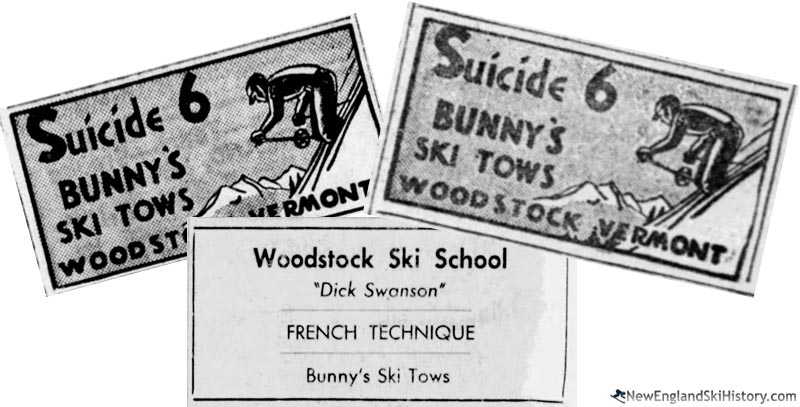
Late 1940s Suicide 6 advertisements |
The 1946-47 season likely started after Christmas, notching one of the best New Year's weekends in years.
A well-timed snow storm resulted in strong Christmas business again for the 1947-48 season. In February, Suicide Six hosted the Eastern Interscholastic Ski Championship alpine events.
The winter of 1948-49 was mild, possibly resulting in a late-January opening. The Fisk Race was cancelled in February "because of the fore-shortened season, which has had no major contests, as yet, to accustom skiers to race conditions," according to the Rutland Herald.
In March of 1949, Suicide Six made headlines when a snow cat was demonstrated on the hill by David Gregg of Nashua, New Hampshire. The Vermont Standard commented on the "strange looking motor vehicle slaloming up the hill," adding, "We've seen everything now."
The 1949-50 season also had a slow start, as the Vermont Standard referred to the first ski weekend of the season in early February as an "almost strange sight of skiers." The Fisk Race was once again cancelled due to safety concerns and a lack of snow. The poor seasons were such a detriment to skiing that the Vermont Standard declared the Woodstock High School ski team as "practically eliminated."
A new rope tow was added for the 1950-51 season, reportedly increasing the total count to four. In December, the Rutland Herald noted of Suicide Six, "the dark implications lurking in the name have inspired thousands of skiers to make the trip to Woodstock just to look at the place. Most of them leave convinced that the area is well-named, for its dizzying pitches are a more than adequate test of good skiers." The season may have started on December 30.
Poma Years
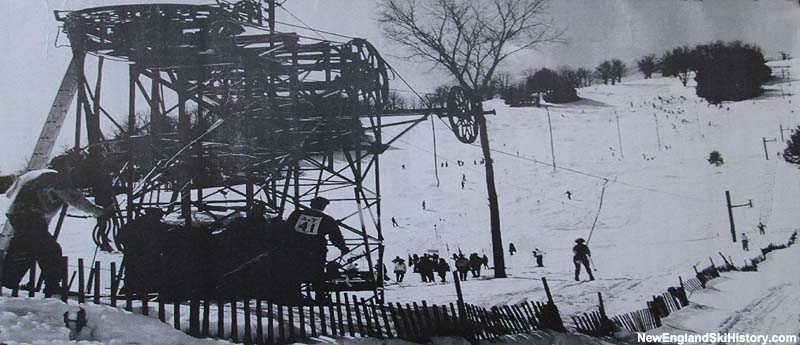
The Poma |
A Poma was added for 1953-54 season, giving Suicide Six a modern lift. At the time, the lift was only the second platter in Vermont. The new technology spread throughout Vermont over the subsequent few years.
Eight acres of new slopes were added for the 1956-57 season.
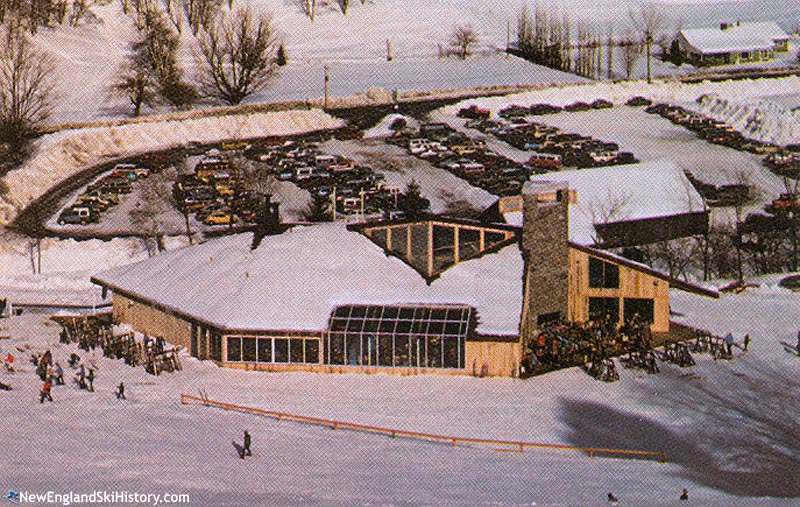
The new base lodge in the late 1970s/early 1980s |
The Rockefeller Era
Bertram sold the ski area to Laurance Rockefeller in 1961, later remarking to Skiing magazine, "I was damn lucky to get out of the business." Rockefeller's RockResorts, Inc. proceeded to market it with its other Woodstock ski area, Mt. Tom, until the latter closed in the late 1970s.
Wanting to have "Cadillac" skiing, Rockefeller pushed through a significant expansion in the late 1970s, starting with the installation of a new double chairlift in 1975-76. A new J-Bar was added in 1977, while a second chairlift was installed in 1978. A new 10,000 square foot, $400,000 lodge was also unveiled for the 1978-79 season, designed by Banwell, White, and Arnold and constructed with butternut and basswood harvested from resort property and heated with a wood furnace.
Shortly after being elected to the U.S. National Ski Hall of Fame, Suicide 6 founder Bunny Bertram passed away on January 29, 1981 at the age of 73. Around this time, RockResorts closed nearby Mt. Tom, as Suicide 6 now had modern facilities for novices.
In February of 1982, Suicide Six hosted the first National Snow Surfing Championship, paving the way for competitive snowboarding.
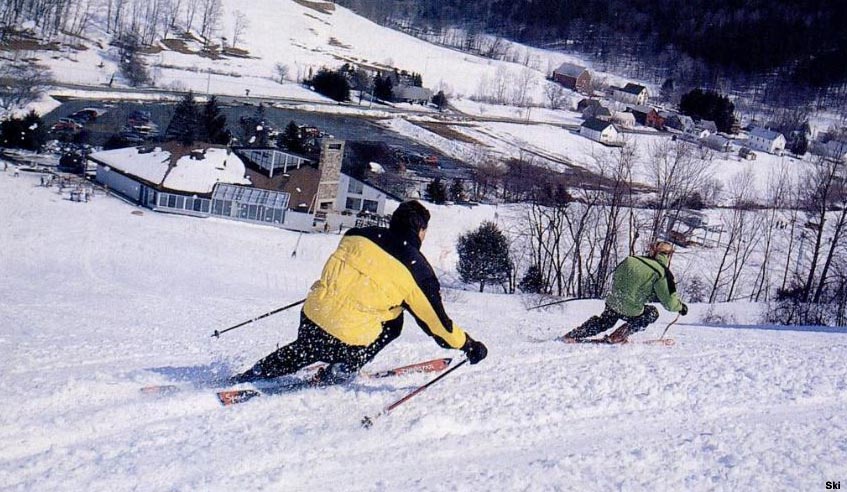
The Face in the 1990s |
As the 1980s progressed, the ski area was spun off from RockResorts, Inc. prior to the corporation being sold to CSX. After the shuffling, Suicide Six and the Woodstock Inn ended up being part of the Woodstock Resort Corporation. Meanwhile, Chuck Vanderstreet was hired to manage the recreational facilities.
With the lodge, snowmaking, and lift investments of the late 1970s and early 1980s, not many visible improvements were made or needed over the next few decades. However, as the 2010s arrived, the summit chairlift began to show its age. After having finding flaws in the aging double chairlift in back to back seasons, Suicide 6 replaced the lift with a new quad chairlift for the 2016-17 season. Meanwhile, Tim Reiter assumed the title of General Manager from Chuck Vanderstreet in 2016 with a goal of making Suicide Six a four season destination.
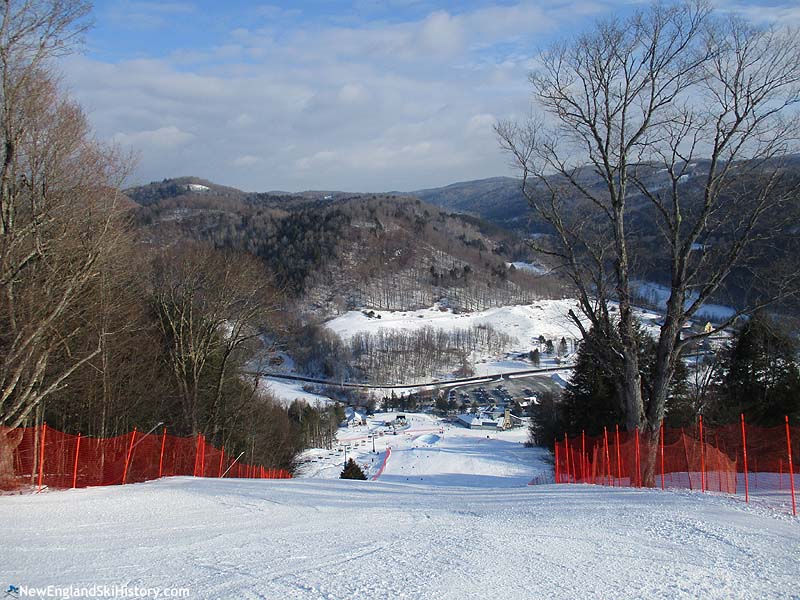
Looking down the Face (2018) |
Once again embracing an emerging competitive sport, Suicide Six was a venue for the FIS Telemark World Cup in January 2018. In July of that year, the quad chairlift began serving downhill mountain bikers.
NewEnglandSkiConditions.com Reports
| Month |
Average Percent of Terrain Open |
| December | 28% (3 reports) |  | | January | 60% (4 reports) |  | | February | 84% (5 reports) |  | | March | 50% (2 reports) |  |
|
| Recent Conditions Reports |
 | Feb. 8, 2025 by beccam
Packed Powder, Packed Powder |
 | Feb. 4, 2024 by rocket21
Loose Granular, Frozen Granular |
 | Feb. 3, 2024 by beccam
Frozen Granular, Packed Powder |
 | Jan. 22, 2023 by brianna
Packed Powder, Packed Powder |
 | Jan. 22, 2023 by rocket21
Loose Granular, Packed Powder |
|
|
| Saskadena Six on NewEnglandSkiConditions.com |
NewEnglandSkiIndustry.com News
| Recent Articles |
| Suicide Six Renamed Saskadena Six - Jul. 14, 2022 | | Suicide Six To Be Renamed - Jun. 28, 2022 | | 2016 Lift Install Season Tied for Worst in History - Dec. 12, 2016 | | Lift Installation Projects Continue as December Approaches - Nov. 27, 2016 | | Lift Installation Projects Continue as Ski Season Approaches - Nov. 13, 2016 | | New England Lift Construction Projects Progressing - Oct. 10, 2016 | | Ski Lift Installations Gearing Up in New England - Aug. 30, 2016 | | Suicide Six to Install New Quad Chairlift - Jul. 1, 2016 | | West Virginia Lift Accident Prompts Modifications to At Least Two Lifts in New England - Feb. 24, 2016 | | Trust for Public Lands Attempting to Purchase Gilbert's Hill Ski Area - Aug. 18, 2015 | | Saskadena Six NewEnglandSkiIndustry.com News Page |
Image Gallery
Lifts
Click on lift name for information and photos
Maps
Year by Year History
Adult Weekend Full Day Lift Ticket; Adult Full Price Unlimited Season Pass. Window price, including RFID fee and taxes when known.
| 2020s |
Ticket Price |
Season Pass Price |
Pass Payback |
Opening Day |
Closing Day |
Skier Visits |
| 2025-26 | |  | |  | | December 20 | | |  | | | 2024-25 | $99.00 |  | $699.60 |  | 7.1 days | December 19 | March 23 | |  | | | 2023-24 | $89.00 |  | $666.74 |  | 7.5 days | December 16 | March 17 | |  | | | 2022-23 | $79.00 |  | $634.94 |  | 8.0 days | December 14 | March 26 | |  | | | 2021-22 | $79.00 |  | $634.94 |  | 8.0 days | December 22 | March 20 | |  | | | 2020-21 | $79.00 |  | $634.94 |  | 8.0 days | December 23 | March 21 | |  | | | 2019-20 | $79.00 |  | $475.94 |  | 6.0 days | December 7 | March 14 | |  | |
| 2010s |
Ticket Price |
Season Pass Price |
Pass Payback |
Opening Day |
Closing Day |
Skier Visits |
| 2018-19 | $72.00 |  | $634.94 |  | 8.8 days | December 15 | March 24 | |  | | | 2017-18 | $72.00 |  | $579.00 |  | 8.0 days | December 18 | March 25 | |  | | | 2016-17 | $68.00 |  | $549.00 |  | 8.1 days | December 20 | March 19 | |  | | | 2015-16 | $68.00 |  | $549.00 |  | 8.1 days | January 7 | March 13 | |  | | | 2014-15 | $66.00 |  | $579.00 |  | 8.8 days | December 19 | | |  | | | 2013-14 | $64.00 |  | $599.00 |  | 9.4 days | | | |  | | | 2012-13 | $64.00 |  | $675.00 |  | 10.5 days | December 26 | | |  | | | 2011-12 | $64.00 |  | |  | | December 22 | | |  | | | 2010-11 | $60.00 |  | $629.00 |  | 10.5 days | | | |  | | | 2009-10 | $59.00 |  | |  | | | | |  | |
| 2000s |
Ticket Price |
Season Pass Price |
Pass Payback |
Opening Day |
Closing Day |
Skier Visits |
| 2008-09 | $57.00 |  | $735.00 |  | 12.9 days | | March 29 | |  | | | 2007-08 | $55.00 |  | $714.00 |  | 13.0 days | | | |  | | | 2006-07 | $52.00 |  | |  | | | | |  | | | 2005-06 | $52.00 |  | |  | | | | |  | | | 2004-05 | $50.00 |  | |  | | | | |  | | | 2003-04 | $48.00 |  | |  | | | | |  | | | 2002-03 | $46.00 |  | $587.00 |  | 12.8 days | | | |  | | | 2001-02 | $46.00 |  | |  | | | | |  | | | 2000-01 | $42.00 |  | |  | | | April 1 | |  | | | 1999-00 | $40.00 |  | $516.00 |  | 12.9 days | | March 26 | |  | |
| 1990s |
Ticket Price |
Season Pass Price |
Pass Payback |
Opening Day |
Closing Day |
Skier Visits |
| 1998-99 | $38.00 |  | $496.00 |  | 13.1 days | | | |  | | | 1995-96 | |  | |  | | December 16 | | |  | | | 1994-95 | |  | |  | | December 17 | | |  | | | 1992-93 | $29.50 |  | |  | | | | |  | | | 1991-92 | $29.00 |  | |  | | | | |  | | | 1990-91 | $28.00 |  | |  | | | | |  | | | 1989-90 | $26.00 |  | |  | | | | |  | |
| 1980s |
Ticket Price |
Season Pass Price |
Pass Payback |
Opening Day |
Closing Day |
Skier Visits |
| 1988-89 | $24.00 |  | |  | | | | |  | | | 1987-88 | $22.00 |  | |  | | | | |  | | | 1986-87 | $20.00 |  | |  | | | March 29 | |  | | | 1985-86 | |  | |  | | December 13 | | |  | | | 1984-85 | $18.00 |  | $244.50 |  | 13.6 days | | | |  | | | 1983-84 | $17.50 |  | $244.50 |  | 14.0 days | December 9 | | |  | | | 1982-83 | $16.50 |  | $228.00 |  | 13.8 days | | | |  | | | 1981-82 | $15.00 |  | |  | | December 11 | | |  | | | 1980-81 | $13.50 |  | |  | | December 12 | | |  | |
| 1970s |
Ticket Price |
Season Pass Price |
Pass Payback |
Opening Day |
Closing Day |
Skier Visits |
| 1978-79 | $10.50 |  | |  | | | | |  | | | 1976-77 | $8.75 |  | |  | | | | |  | | | 1975-76 | $8.25 |  | |  | | | | |  | | | 1974-75 | $7.25 |  | $90.00 |  | 12.4 days | | | |  | | | 1973-74 | $6.50 |  | |  | | January 1 | | |  | | | 1972-73 | $6.50 |  | |  | | | | |  | | | 1971-72 | $6.00 |  | $85.00 |  | 14.2 days | | | |  | | | 1970-71 | $6.00 |  | |  | | | | |  | | | 1969-70 | $5.50 |  | |  | | | | |  | |
| 1960s |
Ticket Price |
Season Pass Price |
Pass Payback |
Opening Day |
Closing Day |
Skier Visits |
| 1968-69 | $4.50 |  | |  | | | | |  | | | 1967-68 | $4.50 |  | |  | | | | |  | | | 1966-67 | $4.50 |  | |  | | | | |  | | | 1964-65 | $4.50 |  | |  | | | | |  | | | 1963-64 | $4.50 |  | |  | | | | |  | | | 1962-63 | $4.50 |  | |  | | | | |  | | | 1961-62 | $4.00 |  | |  | | December 15 | March 31 | |  | | | 1959-60 | $4.00 |  | |  | | | | |  | |
| 1940s |
Ticket Price |
Season Pass Price |
Pass Payback |
Opening Day |
Closing Day |
Skier Visits |
| 1946-47 | |  | |  | | December 29 | | |  | | | 1945-46 | |  | |  | | January 22 | | |  | | | 1939-40 | |  | |  | | January 14 | | |  | |
| 1930s |
Ticket Price |
Season Pass Price |
Pass Payback |
Opening Day |
Closing Day |
Skier Visits |
| 1938-39 | $1.00 |  | |  | | November 26 | | |  | | | 1937-38 | |  | |  | | December 10 | | |  | | | 1936-37 | |  | |  | | December 5 | | |  | |
External Links
Saskadena Six - official site
|
Last updated: May 16, 2023
|



